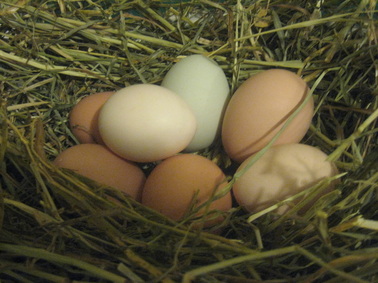Pasture-Raised Eggs

Once you’ve compared an egg from pasture-raised hens to a supermarket egg, you’ll never go back.
First, when you give one of our eggs a gentle tap on the edge of the pan, you’ll probably find it doesn’t even crack. In contrast to the flimsy shell of a supermarket egg, to crack one of ours, you’ll probably have to give it a good whack. Why? Because our hens get extra calcium and other nutrients from pecking for insects as they range, and they convert that into firm, healthy shells.
Second, look at the color of that yolk! Most likely, it’s a deep, orange-yellow, like the color of the prairie sunsets behind our farm. Why? Because our hens are getting plenty of vitamin A from the grass and other greens in their pasture.
Finally, there’s the taste. Now that’s an egg.
You can have them every morning by purchasing an egg share from the farm—a dozen a week from mid-April until about mid-November. (Individuals and small families—don’t worry! You can order a half-share if you’d rather.)
See order form for details.
First, when you give one of our eggs a gentle tap on the edge of the pan, you’ll probably find it doesn’t even crack. In contrast to the flimsy shell of a supermarket egg, to crack one of ours, you’ll probably have to give it a good whack. Why? Because our hens get extra calcium and other nutrients from pecking for insects as they range, and they convert that into firm, healthy shells.
Second, look at the color of that yolk! Most likely, it’s a deep, orange-yellow, like the color of the prairie sunsets behind our farm. Why? Because our hens are getting plenty of vitamin A from the grass and other greens in their pasture.
Finally, there’s the taste. Now that’s an egg.
You can have them every morning by purchasing an egg share from the farm—a dozen a week from mid-April until about mid-November. (Individuals and small families—don’t worry! You can order a half-share if you’d rather.)
See order form for details.